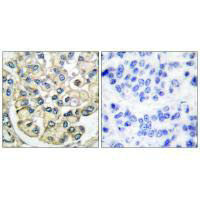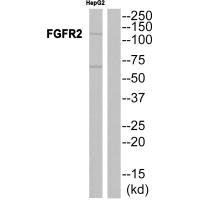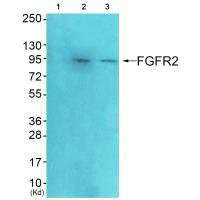
Immunohistochemical analysis of paraffin-embedded human breast carcinoma tissue using FGFR2 antibody.
FGFR2 Antibody

CSB-PA077444
ApplicationsWestern Blot, ELISA, ImmunoHistoChemistry
Product group Antibodies
ReactivityHuman
TargetFGFR2
Overview
- SupplierCusabio
- Product NameFGFR2 Antibody
- Delivery Days Customer20
- ApplicationsWestern Blot, ELISA, ImmunoHistoChemistry
- CertificationResearch Use Only
- ClonalityPolyclonal
- ConjugateUnconjugated
- Gene ID2263
- Target nameFGFR2
- Target descriptionfibroblast growth factor receptor 2
- Target synonymsbacteria-expressed kinase; BBDS; BEK; BEK fibroblast growth factor receptor; BFR-1; CD332; CEK3; CFD1; ECT1; fibroblast growth factor receptor 2; JWS; keratinocyte growth factor receptor; KGFR; K-SAM; protein tyrosine kinase, receptor like 14; TK14; TK25
- HostRabbit
- IsotypeIgG
- Protein IDP21802
- Protein NameFibroblast growth factor receptor 2
- Scientific DescriptionTyrosine-protein kinase that acts as cell-surface receptor for fibroblast growth factors and plays an essential role in the regulation of cell proliferation, differentiation, migration and apoptosis, and in the regulation of embryonic development. Required for normal embryonic patterning, trophoblast function, limb bud development, lung morphogenesis, osteogenesis and skin development. Plays an essential role in the regulation of osteoblast differentiation, proliferation and apoptosis, and is required for normal skeleton development. Promotes cell proliferation in keratinocytes and immature osteoblasts, but promotes apoptosis in differentiated osteoblasts. Phosphorylates PLCG1, FRS2 and PAK4. Ligand binding leads to the activation of several signaling cascades. Activation of PLCG1 leads to the production of the cellular signaling molecules diacylglycerol and inositol 1,4,5-trisphosphate. Phosphorylation of FRS2 triggers recruitment of GRB2, GAB1, PIK3R1 and SOS1, and mediates activation of RAS, MAPK1/ERK2, MAPK3/ERK1 and the MAP kinase signaling pathway, as well as of the AKT1 signaling pathway. FGFR2 signaling is down-regulated by ubiquitination, internalization and degradation. Mutations that lead to constitutive kinase activation or impair normal FGFR2 maturation, internalization and degradation lead to aberrant signaling. Over-expressed FGFR2 promotes activation of STAT1. Xavier Coumoul, Nucleic Acids Res., Jun 2005; 33: e102. Nan E. Hatch, J. Biol. Chem., Sep 2006; 281: 27292 - 27305. Sheri L. Kuslak, Development, Feb 2007; 134: 557 - 565. Anita Petiot, Development, May 2005; 132: 2441 - 2450.
- ReactivityHuman
- Storage Instruction-20°C or -80°C
- UNSPSC12352203


